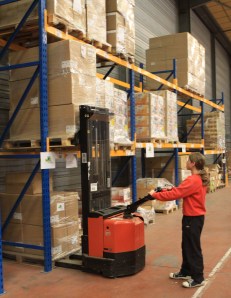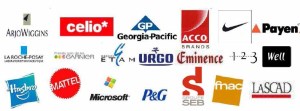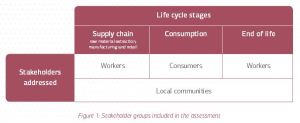Filed under: Best Practices in France, ONG | Tags: Agence de Don en Nature, Associations, Industrial Surplus, Logistics, NGOs, Stock Management, Supply Chain
The ‘Agence de Don et Nature’ (ADN) has become thé intermediary trusted partner between donating enterprises and certified associations in France. Enterprises can donate their unsold goods for the good cause, reassured that items will not be resold. Associations are happy to receive goods against a small financial compensation.. A promising new organisation in France based on a not-for-profit principle inspired by Gifts in Kind International (1).
Stéphanie Goujon, Chief Executive Agence de Don et Nature
Yearly, 400 million euro non-food goods are being destroyed in France (Study AT Kearney Office 2009). Companies are searching for proper destinations of their industrial surplus, but want to be guaranteed that the items are not being resold for legal reasons. They also want to be reassured that the associations that can be trusted. How to find these NGO’s ?
8 million French people live below the poverty line having less than 30 euro per year to spend (study of INSEE in 2009). A few hundred NGOs and Associations are supporting these people in France. NGO’s need money for their activities, but as well.. office furniture, paper, clothes, cleaning products, and so on. Where to find the generous companies that could help them out ?
Organisation Agence du Don en Nature
‘Agence du Don en Nature’ was created in April by a group of French social entrepreneurs, supported by the foundations of Carrefour, l’Oréal and Leyton & Associés, inspired by the American ‘Gifts in Kind International’. It has quickly become known in France as the intermediary logistics organisation, not-for-profit, that matches the needs of charities and offer of non-sold items of enterprises.
AND is run by CEO Stéphanie Goujon. Mrs Goujon has a background in the Fast Moving Consumer Goods sector (P&G, Danone and Unilever). She works in close cooperation with a team of highly qualified volunteers of different backgrounds like private equity, supply chain, HR and Internet.
It became soon obvious that ADN would need a place to store the goods of donating enterprises at a secure place and not too far from Paris where most associations are located. With help of partners Groupe SOS and Fairplace, ADN found a storage of 4000m2 and 5000 palets in Chambly-sur-Oise which is just 30 minutes by car from Paris Gare du Nord.

Agence Don et Nature warehouse of 4000 m2 a Chambly-sur-Oise (60)
Since the start in 2009, already 20 corporate and 38 charity partners have signed up. Last year, products with a value of 6,4 million euro have collected, 2,4 million euros in products have been donated, and between 50,000 and 100,000 people have received the goods via the charities in France.
Benefits for the partner associations
If associations needed clothes, paper or shampoo in earlier times, they were counting on personal relationships between founding partners and enterprise directors. It these relationships resulted in the supply of some goods, the better. Unfortunately, often the right product could not be found, had been already send to the landfill. Or contacts within the enterprises were lacking at all.
ADN allows associations to express their needs for specific products and does all efforts to match this need with the offer of non-sold items from the donating companies. An online product catalogue is available. It can be used to make an order and get the goods delivered. Only a small financial contribution is asked to cover logistic expenses.
The ADN website has a ‘product catalogue’ which shows the actual stock and latest specific items offered by the donating entreprises.
Charities are very enthusiastic. They can now precise their specific needs like ‘toothpaste’ or ‘children underwear’, instead of ‘cleaning products’ or ‘clothes’. The associations only pay a small financial compensation for the logistics costs. A volunteer of ADN makes sure the products are delivered from ADN warehouse to the charities head office within 7 days.
Association partner contract guarantee that items won’t be resold. ADN signs partner contracts with the adhering charities. Among the conditions are the guarantee that items will not be resold, but only used by the volunteers and benefitting people of the association.

Partner Charities of Agence du Don en Nature
Benefits for donating entreprises
Many companies start to remodel their Supply Chains to minimize their stock and unsold goods. Despite these studies, enterprises have to admit it seems inevitable that enterprises maintain to produce goods that end up unsold.
CSR and Sustainability Policies make people realise that it may be a good idea to donate the surplus of brand new goods to charities instead of destroying it.
The Agence du Don en Nature guarantees the donating enterprises that goods won’t be resold on the market and supply a yearly transport report of the destination of the goods. Enterprises are happy to report this in their respective annual Sustainability Report. They can also profit from tax deductions in some cases, though this is certainly not the most important requisite, according to Stéphanie Goujon.
Entreprise partners are very satisfied by ADN services. ‘l’Agence du Don en Nature offers [us] various advantages. As a logistics specialist, she has implemented [both] ethical and transparency parameters [by partner association contracts] which guarantees us from a legal point of view that products are distributed to the right people (4).

Partner Corporates of Agence du Don en Nature
What are outlooks for Agence du Don en Nature ?
One of the key success factors is the high involvement of the donating and founding companies, such as Coca Cola, HSBC, Groupe SEB, ATKearney and Price Waterhouse Coopers, explains Stéphanie Goujon. Supply chain directors and consultancies offer their expertise to set up the logistics and distribution chain. Without this support the association would not be so efficient and successful, Mrs Goujon acknowledges. She is therefore keen on carefully maintaining these partnership relations as ADN keeps growing in the coming years.
Supply-demand balance. Some products are over-asked and currently under-supplied. For instance baby nappies, sleeping bags, socks and baby clothes are very much demanded by the charities, whereas potentials suppliers seem to have found alternative destinations. A new initiative steered by a group of Science Po students (French University of Technology) is the Ambassador Program aiming to understand better the association needs and notably find new donating enterprises for the most required products. This initiative will certainly help to improve the match between the donated goods and requested products.
Ambitious Goals. With all these activities going on, ADN has set itself ambitious goals : By 2011 it wants to help 1 million French people by 2011 by distributing goods representing a value of 10 million euros.
French enterprises and associations are invited to learn about the program and join : www.adn.org : ‘Moins de gaspillage – plus de partage’ or : ‘Less wasting- more sharing’.
Sources : 1. Presentation AND may 2010, 2. Site ADN : http://www.adnfrance.org/, 3. Supply Chain Magazine ‘ADN, une chaîne efficace entre donateurs et associations http://www.supplychainmagazine.fr/TOUTE-INFO/Archives/SCM043/Experience-43-ADN.pdf, 4. Moins de gaspillage, plus de partage’, Rapport d’activité Responsable 2009.
Filed under: Best Practices in The Netherlands | Tags: Akzo Nobel, Bonus, Chemical Sector, Eco Premium Solutions, Eco-Efficiency Assessments, Powder Paint, Supply Chain, Vessels
Few companies have embedded their Sustainable Strategies to such an extend as AkzoNobel does. Top Management Bonuses are related to sustainable KPI’s. Major Business Decisions are made on the basis of both economical as well as environmental impact analyses. My interview with André Veneman, Corporate Director Sustainability, has been very inspiring. Find hereby ‘Best Practices’ at AkzoNobel.
AkzoNobel is a worldwide operating chemical company, employing 58,300 people generating an annual turnover of 15,4 million euros (2008). AkzoNobel has three business units: (1) Decorative Paints, (2) Performance Coatings (industrial, car refinishes, marine and packaging coatings) and (3) Specialty Chemicals.
Product examples : Flexa (Decorative Paint), Fluorex (Car Refinishing – Paint Film on PVC of Volvo ) Resicoat (Industrial Application – Valves)
Hans Wijers, CEO as of 2003 was convinced that Akzo Nobel could only survive if it increased its economical value by reducing its ecological footprint.
Andre Veneman, AkzoNobel Corporate Director Sustainability
André Veneman was sked to lead Sustainable business development together with the management of Health, Safety and Environment.. Veneman accepted, under the condition that the Board of Directors would support him to ‘Go All The Way’ : Implement all processes necessary to embed Sustainability in the organisation. After a career at ‘Doctors Without Borders’ he became determined to organise sustainable processes. He knew this could only be done by throughout analyses, sincere communication and strong interventions.
Veneman started first to create a proper CSR foundation. Veneman and his team analysed all AkzoNobel processes, risks and prepared the company to be ready to match all new standards and legislation. Examples are REACH for Chemical Products, Business Principles embedding, a Vendor Policy to make sure the suppliers actively support AkzoNobel Business Principles and Global HSE standards. A Sustainability Council was installed. NGO’s like Amnesty and WWF were invited to exchange and advise on societal and environmental challenges and the role and responsibility of Akzo Nobel.
An explorative research among suppliers opened they eyes of many. The results of this study, about social and environmental operations of suppliers, showed that some out of 200 suppliers were top class, many of them needed to improve but 8 needed to be removed immediately from the suppliers list. Moreover : The board decided to accompany its key suppliers to improve sustainable circumstances. Nothing to do with philanthropy but business logic : AkzoNobel wants to build partnerships with key suppliers and could not afford that they would be closed down one day or the other. AkzoNobel Sourcing Department now uses Sustainable Supplier Visits to ensure suppliers meet AkzoNobel sustainability standards.
AkzoNobel calculated its ecological footprint in 2007 in six fold, highly structured way: CO2 emissions, water, materials, waste, risk and toxicity. The company generates itself 3 million tons green house gas emissions, but suppliers add 15 million and in the utilisation phase customers are responsible for another 10 million. It makes an overall footprint of 28 million tons C02/year. It is AkzoNobel goal to have reduced its CO2 emissions by 10% in 2015 and by 25% in 2020.
1. What are Corporate Responsibility Objectives of AkzoNobel ?
AkzoNobel has defined three CSR goals (1),defined by the Board in 2008.
1. Remain in the top three of Down Jones Sustainability Indexes. (as of 2007).
2. Reduce total recordable injury rate
3. Deliver step change in people development, partly through substantially improving diversity in the company.
An Eco-Efficiency Analyses for every important Investment Decision (over 5 million euros). For every investment, an ecological summary accompanies the usual financial business case. Veneman explains that it has happens more than once that investment scenario’s with a smaller financial gain for lower ecological are being prevailed above others scenarios that would result in higher revenues but a substantial larger ecological footprint.

Simplified and fictive example of combining financial and ecological summaries as input for the companies investment decisions
2 How does CSR contribute to Innovation ?
AkzoNobel is continuously innovating in its three main key industries : Construction (responsible for 35% of the companies revenues), Transport, (20%) and Energy (40%). Subjects of improvement are functional performance (solvability, drying time and scratch resistance) and eco indicators (toxicity, energy efficiency, natural resources, emissions of waste, land use and risks).
18% of the product portfolio consists of Eco-Premium Solutions. The Eco-Premium Products all have a clear ecological advantages with a normal or better functional performance. By 2015, AkzoNobel wants to have the proportion increased to 30%.
An Eco-Premium example is ‘Dissolvine GL’, a chelating agent. Chelators serve inactivate (metal) ions in liquids. Among other application areas are shampoos and food products. Dissolvine GL is based on 86% non-fossil and sustainable resources. Ammonia is produced as a side-product but can be collected and re-used.

Molecules Model of a chelating agent that is used to inactivate metal ions. Dissolvine GL is one of the ‘chelating agent’ products of Akzo Nobel, an Eco-Premium product representing a high economical value with a low environmental impact.
50% of Managers Bonus is now related to Sustainable Development. Half of the yearly variable bonus of the Top 1000 executives is now directly related to sustainable performance, which consists of Eco-Premium Innovations, carbon reduction, safety, operational efficiency talent development and the companies position in the DJSI index.
Exchanges with NGO lead to new product ideas. An NGO explained AkzoNobel 12 years ago that classical biocidal antifoulings had to be phased out because of their toxicity to marine life. It motivated AkzoNobel to develop non stick, smooth polymer antifoulings. Scallops and see weed will not attach. Due to the very smooth hull, large container sea ships now could save more than 6% petrol use : An economical and ecological gain. global shipping is responsible for 2,7% of the worlds green house gas emissions (2009 numbers). The use of this very smooth Intersleek antifouling alone could potentially reduce global carbon-emissions of containerships with 80 million tons compared to classical antifoulings.
New polymer ship coating (Intersleek 900) that enables an energy consumption of over 6% of vessels
Customer exchanges that launch new product innovations. Akzo Nobel has set up various customer exchanges. Discussions are moving towards a more extensive needs analyses. Questions are ‘What challenges do you face with respect to Sustainability’ ? ‘What would you expect from us in terms of products and services?
An example of a product developed by intensive involvement with stakeholders is ‘Redicet’, launched in 2007. Redicet is an asphalt product (or butimen). Redicet is stronger and more resistant than the other asphalts on the market. It enables a more efficient transport which means energy savings for car drivers. The road workers working circumstances have improved substantial : The asphalt does not to be heated at a very high temperature and pollution has been reduced. Lastly, an overall cost reduction of 20 to 40% is possible.

Redicet, a new asphalt with higher performance, lower pollution and better working circumstances
Painting powder that can be melted at lower temperature. Office furniture makers asked AkzoNobel to develop lower paint powder temperature (now 230 degrees) that enables to lower the producers energy spend and environmental footprint. It has been the start of new developments.

Office furniture (Arféo) coloured with powder paint.
3.What are outlooks ?
Sustainability has been embedded and can only accelerate, Veneman concludes. At AkzoNobel, after having created the foundations, and embedding sustainable decisions into the companies strategy, Veneman foresees further cooperation between departments.
One of the next steps will be a structured and common approach for co-creation with customers, NGO and industry partners. In order to create new innovations stakeholders will be increasingly implicated in the process. Among other implications, it will bring new definitions of intellectual property and responsibilities between AkzoNobel and its partners.
Sources : 1. Delivering Tomorrows Answers today, Akzo Nobel 2008 Report ; 2. The Carbon Footprint of Shipping, 2009 by Joint NGO’s (Seas at Risk, Milieudefensie, Noordzee Foundation),
















